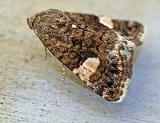
Tyta luctuosa
Encyclopedia
Tyta luctuosa is a noctuid
("owlet") moth
. Its common names include four-spotted moth and field bindweed moth. It is the only member of the genus
Tyta, which forms a hitherto monotypic
tribe
Tytini in the Catocalinae
subfamily.
 This moth is native to much of Europe, Asia, and North Africa. The adult moth is about eleven millimeters long and dark brown with one large white spot on each of its four wings. Two adult generations emerge each year, one in late spring and one in summer. In warm areas there is often a third generation. The female lays about 400 to 500 eggs. The larva
This moth is native to much of Europe, Asia, and North Africa. The adult moth is about eleven millimeters long and dark brown with one large white spot on each of its four wings. Two adult generations emerge each year, one in late spring and one in summer. In warm areas there is often a third generation. The female lays about 400 to 500 eggs. The larva
is a brown caterpillar
. The larva is the destructive stage. It eats leaves and flowers, especially new buds. This is the desired effect of this moth when it is used as an agent of biological pest control
against field bindweed
(Convolvulus arvensis). It was first introduced into the United States in the 1980s to attack this agricultural weed, which is its main foodplant.
Noctuidae
The Noctuidae or owlet moths are a family of robustly-built moths that includes more than 35,000 known species out of possibly 100,000 total, in more than 4,200 genera. They constitute the largest family in the Lepidoptera....
("owlet") moth
Moth
A moth is an insect closely related to the butterfly, both being of the order Lepidoptera. Moths form the majority of this order; there are thought to be 150,000 to 250,000 different species of moth , with thousands of species yet to be described...
. Its common names include four-spotted moth and field bindweed moth. It is the only member of the genus
Genus
In biology, a genus is a low-level taxonomic rank used in the biological classification of living and fossil organisms, which is an example of definition by genus and differentia...
Tyta, which forms a hitherto monotypic
Monotypic
In biology, a monotypic taxon is a taxonomic group with only one biological type. The term's usage differs slightly between botany and zoology. The term monotypic has a separate use in conservation biology, monotypic habitat, regarding species habitat conversion eliminating biodiversity and...
tribe
Tribe (biology)
In biology, a tribe is a taxonomic rank between family and genus. It is sometimes subdivided into subtribes.Some examples include the tribes: Canini, Acalypheae, Hominini, Bombini, and Antidesmeae.-See also:* Biological classification* Rank...
Tytini in the Catocalinae
Catocalinae
Catocalinae is a subfamily of moth family Erebidae . Many of the species are large compared to other noctuids in temperate zones, and have brightly colored backwings....
subfamily.

Larva
A larva is a distinct juvenile form many animals undergo before metamorphosis into adults. Animals with indirect development such as insects, amphibians, or cnidarians typically have a larval phase of their life cycle...
is a brown caterpillar
Caterpillar
Caterpillars are the larval form of members of the order Lepidoptera . They are mostly herbivorous in food habit, although some species are insectivorous. Caterpillars are voracious feeders and many of them are considered to be pests in agriculture...
. The larva is the destructive stage. It eats leaves and flowers, especially new buds. This is the desired effect of this moth when it is used as an agent of biological pest control
Biological pest control
Biological control of pests in agriculture is a method of controlling pests that relies on predation, parasitism, herbivory, or other natural mechanisms...
against field bindweed
Convolvulus arvensis
Convolvulus arvensis is a species of bindweed, native to Europe and Asia. It is a climbing or creeping herbaceous perennial plant growing to 0.5–2 m high. The leaves are spirally arranged, linear to arrowhead-shaped, 2–5 cm long and alternate, with a 1–3 cm petiole...
(Convolvulus arvensis). It was first introduced into the United States in the 1980s to attack this agricultural weed, which is its main foodplant.

